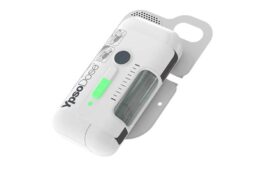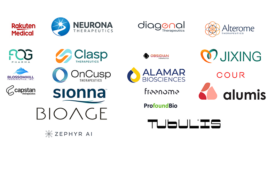
Flow chemistry image courtesy of Vernalis Research
Flow chemistry is a growing technology in the pharma industry, where it has proved itself invaluable, especially in the process development phase of drug discovery. However, the hit-to-lead generation phase of drug discovery has been slower to embrace these techniques. Nevertheless, the potential benefits are huge, particularly for rapid library generation and challenging chemistries that were previously hard to achieve by traditional batch methods. This article looks at how finding a groundbreaking flow chemistry application led to the wider adoption of flow chemistry in synthesis at a small pharma company.
The pharma industry frequently collaborates with CROs and smaller technology companies in the lead generation phase of drug discovery, adopting a medicinal chemistry approach to the development, synthesis and analysis of drug molecules and other bioactive agents to deliver novel candidates for the development of new medicines. The use of fragment-based approaches that exploit low molecular weight binders to the protein leads to the subsequent development of high-quality leads. The most promising of these leads are optimized using multidimensional methods to generate high-value candidate compounds.
Finding the game-changer
Hit-to-lead chemistries are constantly changing. Each target molecule informs the design of the next. Traditionally, this iterative cycle has been accomplished using batch chemistry, as the new desired target often changes the synthesis. This partly explains why hit-to-lead chemistry and fragment-based approaches have generally been slower to adopt the alternative flow chemistry approach.1 Medicinal chemists are seeking a single platform capable of performing the range of reactions that they currently carry out at comparatively lower cost in a round bottom flask. For flow chemists, the challenge is to convince their colleagues that the initial investment required to adopt this technique will be recouped through the benefits it delivers. The answer lies in finding an application that enables chemistries that are particularly difficult to achieve by other means. For Vernalis, a leader in fragment-based approaches, this came with the publication of a paper describing the on-demand synthesis of organozinc halides under continuous flow conditions,2 a challenging chemistry that is hard to reproduce reliably in batch. The paper by Alcázar and coworkers highlighted how the technique cannot only be used for challenging capricious chemistries but also to undertake these reactions on demand.
Library generation
While the use of flow chemistry for library generation is not new, the technique is not as widely employed as it is for scale-up because it is a continuous process. Organozinc reagents are versatile building blocks for cross-coupling—such as the Negishi reaction—to form C(sp2)-C(sp3) and C(sp3)-C(sp3) bonds for complex organic structures and late-stage functionalization. However, their use has been limited due to their instability and air and water sensitivity, limiting laboratories’ ability to handle and store the reagents. Preparation in batch is also challenging to reproduce reliably. The use of continuous flow conditions overcomes these limitations, enabling on-demand synthesis of these versatile reagents in situ before subsequent reactions—avoiding ingress of moisture or air—and supporting their re-adoption in synthetic organic chemistry. This was the game-changing application of flow chemistry, which allowed Vernalis to consider these types of chemistries feasible for library generation.
Entering a realm of continuous flow
Vernalis was quick to explore the potential of this application, initially using a system created in-house before investing in a modular Syrris Asia platform. Library generation was performed via a slug flow process, using the software-controlled, automated reagent module to load the injection loops and prepare aliquots of different substrates before each undergoes the same reaction protocol.
There are several advantages to this approach over conventional batch set-ups. Firstly, the injection loops are filled under a positive pressure of nitrogen, which is a huge benefit when handling air or moisture-sensitive compounds. A further advantage is that more than one reaction can pass through the system at a time, allowing for rapid, efficient library generation compared to batch processes. Sophisticated software ensures precise control over timing, enabling excellent segment tracking, and synthesis can be performed on demand on a thousands of microliters scale. In addition, a slug chasing approach that uses short gaps between successive reactions can be set up, delivering both solvent and time savings.
Scale-up made simple
Once a promising hit molecule has been identified, the next step is to resynthesize the compound in larger quantities for further investigation. Depending on the reaction, scaling up in batch may need to be done in increments due to safety considerations. This may not necessarily result in an identical outcome to the same reaction done on a smaller scale. With flow chemistry, this is a much more straightforward process; simply switch to continuous flow and allow the reaction to run until sufficient compound has been collected, without the need for any re-optimization. In some cases, this also avoids any need for additional purification steps.
Conclusions
Flow chemistry offers exquisite reaction control compared to batch processes, which are influenced by parameters such as volume, speed of addition and rate stirring that are difficult to replicate reproducibly. This exceptional control ensures that reactions are consistent and repeatable and enables medicinal chemists to undertake capricious chemistries involving air and moisture-sensitive substrates, which would otherwise be difficult to achieve using batch techniques.
For medicinal chemists embarking on flow for the first time, the key to successfully implementing the technique and achieving challenging chemistries lies in talking to experts in the field, from published authors to commercial system vendors with a good understanding of drug discovery. They should also look for a single system that can accommodate every reaction performed by batch processes. A modular platform is ideal, allowing different units—such as heating and cooling, electrochemistry and photochemistry modules—to be purchased as and when required and interchanged according to the chemistry involved. This ensures that all the reactions traditionally performed in batch can be reliably and consistently undertaken rapidly inflow, giving pure products with excellent yields and selectivity.
- Gioiello, A., Piccinno, A., Lozza, A.M. and Cerra, B. The Medicinal Chemistry in the Era of Machines and Automation: Recent Advances in Continuous Flow Technology. J Med Chem 63, 6624-6647 (2020). https://pubs.acs.org/doi/abs/10.1021/acs.jmedchem.9b01956
- Berton, M., Huck, L. and Alcázar, J. On-demand synthesis of organozinc halides under continuous flow conditions. Nat Protoc 13, 324-334 (2018). https://doi.org/10.1038/nprot.2017.141
Lee Walmsley is senior team leader, chemistry at Vernalis and Andrew Mansfield is flow chemistry leader at Syrris.
Filed Under: Drug Discovery and Development





Tell Us What You Think!
You must be logged in to post a comment.